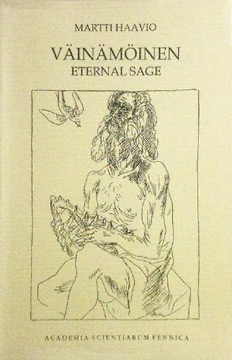
Väinämöinen: Eternal Sage PDF
Preview Väinämöinen: Eternal Sage
• • V Ä I N Ä M Ö I N E N E T E R N A L S A G E BY MARTTI HAAVIO Professor of Oral Tradition at The University of Helsinki Translated from the Finnish by Helen Goldthwait-Väänänen PORVOO • HELSINKI WERNER SÖDERSTRÖM OSAKEYHTIÖ V Ä IN Ä M Ö IN E N IIl'MINKI 100« HKI,.«IINOIN LIIICKKIRTAMINO OY FOREW ORD Väinämöinen is the most outstanding figure of the Kalevala, Everyone who has read Finland’s folk epic has formed an idea of him, and in literature a great number of descriptions are to be found. The oldest of these was written by Elias Lönnrot himself — »In these runes Väinämöinen is usually spoken of as grave, wise, and full of foresight, working for the good of coming generations, omniscient, powerful in incantation and in music — the hero of Finland. Furthermore, he is called old, although his age alone did not much affect his courting.» On the whole, this is the Väinämöinen of the Kalevala. But there is another Väinämöinen — the Väinämöinen of folk poetry. In these pages I shall try to sketch in his character, using for my sources chiefly those crumbs ofinformation to be found in the Old Runes of the Finnish People. Now that my task is finished, I feel that I have come to conclusions that modify considerably the concept of Väinämöinen founded on the Kalevala, as well as that which the older scholars formed of him based on folk poetry proper; and again, that image which I had formed in my own mind. This revaluation is, in my opinion, necessary. On the other hand, let me quote the words of Kaarle Krohn: »I have attempted to place each matter in its compartment; whoever finds it does not fit in one, let him take and put it in another.» I am grateful to my friends Dr. Matti Kuusi and Dr. E. A, Virtanen for having read my work and for making several excellent observations which I profited by. My gratitude is due my wife also, Dr, Elsa Enäjärvi-Haavio, who followed the progress of my work from the beginning, and whom I consulted on numerous difficult problems. Her help greatly facilitated their solution. In 1828 K. A. Gottlund, in his work Väinämöiset, published his versified myth of the stars. To Väinämöinen comes, Gottlund relates, the warrior heroes of Troy and of the Roman poets, begging him to play on the kantele. After long hesitation before so awesome and dignified an audience, Väinämöinen begins to sing runes. ' He sings delightfully and without pause for three days on end. On the third day it comes to pass that the Creator Himself is enchanted 'with his (j Miililt lluuvloi VUinflm^iiuMi singing; and the kantele is changed into star rays, its nails into moon beams, and its strings into sunbeams. After this comes about, the heroes of Troy and the poets of Rome extol Väinämöinen as the greatest of them all. Orpheus and Ossian cede him the place of honor. The Muses had not found a more excellent musician in the heavens. And Homer himself, charmed by this son of Hyperborea, takes him by the hand and embraces him. Gottlund’s poem is naive, even more naive than the resumé of it in prose. Nevertheless, I feel that the young romantic’s admiration for the ancient Finnish songs — his intention was to emphasize their significance through comparison with ancient poetry and with the songs of Ossian — is fully justified. And although in the following pages I seldom discuss the esthetic value of the runes, during the writing of this study I have come to understand more and more vividly this particular facet, for I have tried to explain how beauty is created. Martti Haavio Sammatti, August 1950 FOREWORD TO THE ENGLISH EDITION This study of mine is now appearing in an English language edition because certain foreign friends urged that it be published in a language more generally accessible than Finnish. The work of translating was rendered especially difficult owing to archaisms, to the many dialects represented in the citations and to the fact that a great number of dialectal words are not to be found in any dictionary. I should like here to express my thanks to the translator, Mrs. Helen Gold- thwait-Väänänen, who has worked painstakingly and without stinting time or effort. In the original edition there was no index; the index in the English edition is also the work of Mrs. Väänänen. Professor Séamus Õ Duilearga of University College, Dublin, undertook to read the typescript of the book, and Professor Daniel Aaron of Smith College, Northampton, Mass., the galleys. To both of them I owe the warmest gratitude for this proof of their interest and friendship. The Committee for the Finnish Literature Fund has given a grant- in-aid to be applied to the expenses of translation. Martti Haavio Helsinki, May 1, 1952
